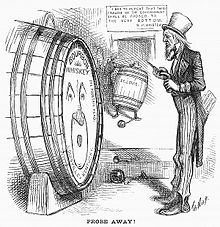Whiskey ring

Whiskey ring was the name of a group of men who shoved several million dollars into their own pockets from the liquor tax in the United States in the 19th century . The ring was composed of the immediate environment of President Ulysses S. Grant and was just one of several scandals that shaped his tenure. The ring began its activities in 1871, and was discovered and dissolved in 1875.
Figures included Grant's private secretary, Orville E. Babcock, and St. Louis regional finance director , John A. McDonald. The whiskey ring began its activities in St. Louis in 1871, but was also organized in Chicago , Milwaukee , Cincinnati , New Orleans and Peoria .
The illegal activities were based on widespread bribery of tax collectors and merchants. The spirits tax had to be paid by the distilleries depending on the amount of alcohol produced. Tax officials who were active for the Whiskey Ring estimated the amount of alcohol too low and had part of the tax difference paid out in cash. They said that this was for a higher cause - the dollars raised would be raised to support Grant's next election campaign. Should an honest financial officer visit the company, the owners have been warned to follow the rules this time in order not to arouse suspicion.
Treasury Secretary Benjamin H. Bristow dissolved the ring in 1875. Rumors of the deal had been circulating for several years, and one of Bristow's first acts was to convince Congress to donate money to investigate the rumors. Bristow hired journalist Myron Colony to investigate the rumors, and he gathered enough information to prove his activities to John A. McDonald in St. Louis. John A. McDonald, in turn, tried to show active remorse by proposing an exchange to replace the money in compensation for a back payment of the embezzled taxes and at the same time burdened Grant and his environment. Grant himself turned against the ring in this situation, made it clear that he supports a law enforcement and within a month 300 Brenner and government employees were arrested.
However, when the evidence against Grant's private secretary Orville F. Babcock condensed, Grant changed course again, refused to believe the evidence and publicly cleared McDonald of suspicion, as he was friends with the impeccable Babcock. Grant also questioned incriminating telegrams linking McDonald, Babcock and the Whiskey Ring, some of which were stolen - allegedly from a man commissioned by Grant.
Babcock was still charged in 1876, but acquitted on the basis of a statement by the President. Grant also made sure that Babcock returned to his old post, from where the internal administration transferred him to the monitoring of lighthouses after just a few days . McDonald was sentenced to $ 5,000 and three years in prison. In the October 1875 trial in Jefferson City, Montana, 110 convictions were handed down and over $ 3 million in taxpayers' money recovered.
Grant's efforts at Babcock and McDonald generated numerous rumors that either himself or his son Fred and brother Orivile were part of the ring. McDonald himself said in a later written book for his own relief that he always assumed that the instructions came directly from Grant.
Remarks
- ↑ a b c d e f g Gary Regan, Mardee Haidin Regan: The Book of Bourbon . Jared Brown, 2009, ISBN 978-1-907434-09-9 .
Web links
- Timothy Rives: Grant, Babcock, and the Whiskey Ring. In: Prologue. Fall 2000, Vol. 32, No. 3.
- Whiskey Ring Scandal. on: american-presidents.org
